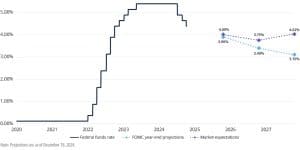As we turn the page on 2024, a new chapter begins filled with new opportunities as well as obstacles we must face in our lives and investment portfolios. With the backdrop of a new administration entering the White House and the Republican sweep of Congress, 2025 is shaping up to be a year of significant change. Let’s look at the top investing questions for the year ahead and the potential implications for your portfolio.
1. How low will rates go?
The Federal Reserve began easing rates in September with a half-point cut followed by a quarter-point cut in November and another in December, lowering the federal funds target range from 5.25%-5.50% at its recent peak, to 4.25%-4.50%. The question remains — how much lower will the Fed go in 2025? The Federal Open Market Committee (FOMC) released projections in December, with the most hawkish committee member expecting no more rate cuts to occur in 2025, while the most dovish member expects to lower rates by 1.25% by year-end. As of December 18, futures markets were projecting one more quarter-point cut in 2025. However, as the Fed would suggest, the outlook for the path of rates remains uncertain. As new economic data comes in, the Fed adjusts accordingly and given the impending policy changes under the Trump administration, it’s difficult for anyone to predict exactly what will end up happening.
Federal Funds Rate Projections:

2. How will the Trump administration’s policies affect the economy?
While the presidential election results are still fresh and the new administration’s policy objectives still need to be ironed out, a few major policy points discussed throughout the election campaign may provide some insight. However, it’s important to keep in mind that the political landscape is continuously changing, and there will likely be adjustments to the policies that the Trump administration ultimately rolls out.
- Tax cuts: Key provisions from the 2017 Tax Cuts and Jobs Act (TCJA) are set to expire at the end of 2025. The new administration will likely extend the TCJA, and it is also possible that they will push for a lower corporate tax rate for domestic production. Over the short run, these tax cuts could stimulate the economy and boost GDP growth. Longer term, they would lead to a larger federal deficit without an equal or greater offset.
- Higher tariffs: Putting aside any potential geopolitical ramifications, the proposed 10% tariff on all imports and 60% tariff on Chinese goods may result in higher inflation and interest rates.
- Reduction in immigration: Heavily reducing immigration could lead to decreases in the growth of the labor force and subsequently lower economic growth. Additionally, wages could increase, leading to higher inflation.
- Corporate deregulation: The specifics on the deregulation policies the new administration plans to implement are murky at best. However, in general, corporate deregulation could lead to increases in capital investment and hirings.
3. Will the U.S. stock market continue its impressive climb?
The five-year return for the S&P 500 was 15.8% through the end of November 2024. The average five-year return since 1926 has been 10.3%. Excluding the year 2022, we’ve seen double-digit returns over the past five calendar years.
Many investors are feeling euphoric with this increase in wealth. The American Association of Individual Investors conducts a regular survey of members to see if they are bullish, neutral, or bearish. The most recent survey indicates that their members are bullish with an average reading during 2024 of 44.5%. Since 1987 the average reading has been higher in only three years: 2000 (49.4%), 2003 (48.4%), and 2004 (49.0%). For additional context, the average since 1987 is 37.7% and the low was observed in 2022 with an average of 24.7%.
While returns have been excellent and investors are optimistic, downside risks remain. The Goldman Sachs Global Strategy Paper No. 71 made headlines in the fall with the forecast that the S&P 500 will deliver a return of only 3% during the next 10 years. This forecast was primarily informed by two structural forces:
- Current valuations for the S&P 500 are high. The price relative to a dollar of earnings is near its all-time high since 1930. Starting valuations are far from a perfect predictor of performance, but they currently point to muted returns going forward.
- Market concentration is at a high level. The authors point out that concentration matters for long-term returns. Their analyses showed that it is extremely difficult for a company to maintain high levels of sales growth and profit margins over long periods, and the same goes for a highly concentrated index. According to the report, “As sales growth and profitability for the largest stocks in an index decelerate, earnings growth and therefore returns for the overall index will also decelerate.”
Although we do not recommend that investors make any major changes to their portfolios based on these observations, this is an excellent time to conduct a portfolio review. It may be appropriate to update your financial plan to see if there is an opportunity to realize gains in U.S. stocks and redeploy into international stocks with more attractive valuations or lower risk fixed income assets.
For informational and educational purposes only and should not be construed as specific investment, accounting, legal, or tax advice. Certain information is based on third-party data and may become outdated or otherwise superseded without notice. Neither the Securities and Exchange Commission (SEC) nor any other federal or state agency have approved, determined the accuracy, or confirmed the adequacy of this article. Please be advised that Buckingham only shares video and content through our website, Facebook, LinkedIn page, and other official sources. We do not post investment advice on WhatsApp, Telegram, other interactive applications, or other similar platforms. Rather, Buckingham provides investment advice only through individualized interactions. R-24-7987.



